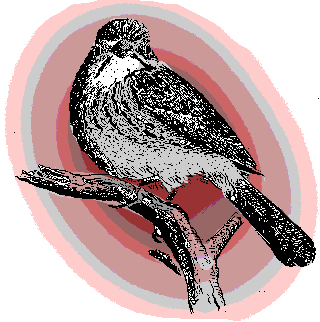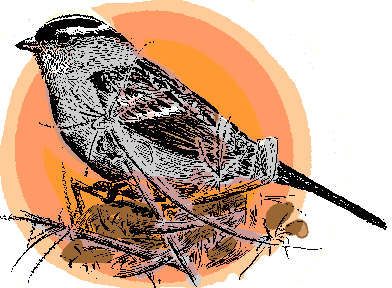Adapted from Jim Conrad's online book A Birding Trip through Mexico, This excerpt from "Grassland-Mesquite"
northern Chihuahua state
SPARROWS IN A CHIHUAHUAN GRASSLAND

Sparrows, so many sparrows this morning, peeping and rustling in the leaves outside the tent. So as to not frighten them away I furtively peep through a pinhole beneath the tent-flap's zipper. Outside I see a carnival of mostly brown and gray, stubby-billed, chubby looking little sparrows, hopping about, scratching in the soil, preening, stretching, and flitting from one grass stem or sagebrush branch to another.
Mexico has about thirty-eight sparrow species and they all are variations on the themes of smallness, being gray and brown, typically having striped backs, and having bills that are short and conical, and thus well adapted for eating small grass seeds. Not a species among them bears a single feather of blue, green, or red. Male and females look the same, but juveniles have their own plumages, which are even less striking than the adults'. And around me this morning, seventy to eighty percent are young birds in various stages of drab juvenile plumage. They are this year's new crop. Identifying them will be a challenge and a pleasure.
I'm able to name two or three species immediately because of the presence of a few adult birds with distinctive fieldmarks. However, to positively identify six sparrow species it takes two days of patient watching, of reading and rereading species descriptions in my field guide, of studying habitat preferences and species ranges, and of vainly hoping that an adult male will break into its distinctive song.
For two days I drift through the tall grass and among the low, spiny mesquites and acacias, meditating on the meanings of lesser or greater degrees of brown striping on backs, lesser and greater degrees of spotting on chests, mere hints of eye rings or eye stripes, mere hints of median crown stripes, and occasional, half-hearted, fractionally articulated songs. And these two days are a joy.
You need special powers of observation to identify birds well. I look at one of these sparrows, make all the mental notes I can on breast spotting and back streaking, on whether it has an eye stripe or an eye line, or maybe a line through its crown. Once I think I've noted everything, I put down the binoculars and look in the field guide, and then I realize I hadn't seen nearly enough.
Had the bird's tail been forked, squared, or rounded? Had its lower mandible been the same color as the the top one, and had its legs been dark or pale? Nearly always by the time I realize that I must look at the bird again, already the sparrow has flown away. I feel as if all these sparrows orbiting around me in their flitting, ephemeral, seemingly unconcerned manner comprise a kind of diffuse Zen master who half teasingly, half tauntingly draws me into a frame of mind where, to glimpse the essential beauty of the thing, ever greater self-discipline is needed, ever clearer vision.
In the end, knowing that I've probably overlooked two or three species, here, in alphabetical order, are the six sparrows I identify with absolute certainty:
Now let me tell you about each of these:
BLACK-THROATED SPARROW --photos and more info
Adults wear conspicuous black bibs below their bills, and bold, white eyebrow lines over their eyes. The species limits itself to desert scrub and has a special fondness for creosote bush. The bird's range is smaller than a lot of sparrows', only nesting as far north as southeastern Colorado, and wintering as far south as central Mexico It's absent throughout the East. The bird flies erratically and close to the ground, nervously flicking its tail, almost as if it were jittery about something. This a restrained, neat-looking, nervous little bird.
CLAY-COLORED SPARROW -- photos and more info
Particularly small, this bird has no striking feature of plumage other than a modest, pale stripe across a dark-brown head-crown. More a generalist than the scrub-loving Black-throated Sparrow, it inhabits a hodgepodge of habitats -- scrub, second-growth, edges of both deciduous and coniferous forests, burns, along rivers... Its song, which isn't being sung now, is nothing musical, rather just three to four identical, slow, low-pitched, flat, unbirdlike buzzes. Studies have shown that the pure, clear whistles of forest birds become severely distorted by strong temperature gradients and air turbulence. The Clay-colored Sparrow's low-pitched buzzes, then, is adapted for windy, open places just like this. Most North American birds are found in either the East or the West, or from coast to coast, but Clay-colored Sparrows only occupy the center of the continent. You can see its summer breeding distribution here. The species winters from southern Texas to southern Mexico.
RUFOUS-CROWNED SPARROW -- photos and more info
This is by far the most abundant species here, with more juveniles in more intermediate stages of confusing plumage than any other. It forages on the ground seldom moving high in vegetation. Often it scurries from one bush to another instead of flying. Sometimes it sings a few snippets of song, even though nesting time is far away. The song is a little musical, with many rapid notes, but the notes are weak and jumbled with no discernable structure. One feature setting it apart from the other five sparrow species is that it's the only one that doesn't migrate. I take this to mean that of all the birds here, this is the one most at home.
SONG SPARROW -- photos and more info
This bird is "family" for me. Distributed from southern Alaska to Newfoundland, south at least to southern Mexico, it was with me in my old Kentucky home. Though several generations of bird were probably involved, my mother considered the Song Sparrow claiming our backyard as the same individual year after year, and she called him Chesty. "Chesty," because when he sang he threw back his head and puffed out his boldly striped chest. My mother would always say, "Just listen to Chesty out there singing his little heart out."
VESPER SPARROW -- photos and more info
The books always speak of the Vesper Sparrow's sweet song. I've never been up North during the species' nesting season so I don't know how sweet the song is. To see if you agree with The Audubon Society Master Guide to Birding's description of the song as ". sweet, musical opening notes, usually 2 pairs of clear, unhurried, slurred notes, second pair higher pitched, followed by a descending series of rapid trills," you can hear the song here. Not having its song to help with identification, I'm glad that Vesper Sparrows have an easy-to-see fieldmark. Their shallowly notched tails have white outer feathers that flash when the bird flies. A few other sparrow tails have white outer feathers, but those tails are rounded, not notched.
WHITE-CROWNED SPARROW -- photos and more info

This bird also has a vast range, nesting as far north as northern Alaska and northern Quebec, and wintering as far south as central Mexico. Though as a child in Kentucky I knew this bird, it was fairly uncommon and appeared there only during the winter. In the picture, notice the bold, black-and-white head striping. In Volume 146 (1964) of Science magazine, L.R. Mewaldt reported on an experiment for which he'd captured White-crowned Sparrows in San Jose, California, marked them and flown them by aircraft to Baton Rouge, Louisiana, and Laurel, Maryland, where the birds were released. The following summer they presumably migrated to their nesting grounds, most likely in Alaska, and then the following winter they showed up once more in San Jose, California... If you know how hard it is to get a fix on one's longitude (east-west position), you'll understand how surprising this is.